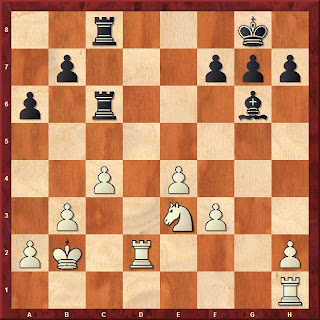That said, I start the lesson (as he suggests) with a general discussion of what a threat is: how in real life, a threat is bad ("I'm going to beat you up after school," "I'm going to tell," etc.) but in chess, a threat is great ("I'm going to take your piece") because it gives you a chance to be winning next move. The more threats you make, the more chances you give your opponent to make a mistake, and the more chances you will get an advantage.
In chess, a threat has to be specific, so when I ask "what's the threat?" I am really asking "Where are going going to move next turn?" and you should give me a specific answer, like Qxg7, rather than a vague answer, like "checkmate." For a threat to work in either real life or chess, it has to be something that the other guy is actually scared of. So if I say "I'm going to give you a piece of cake," that isn't a threat, and neither is threatening to play QxP if they can just recapture your queen.
Here's Coakley's position:
He talks about the following threats:
- 1. Be3, threatening to take the black queen.
- 1. Bd6, threatening to win the exchange
- 1. Qg2, threatening Qxg7#
- 1. Qd2, threatening the sacrifice 2. Bxh6
- 1. Be5, threatening to double black's pawns
- 1. Qe3, threatening to trade queens, since white is up material
- 1. Bg5, threatening the queen;
- 1. Qa4, threatening the knight for a second time (a good opportunity to review counting attackers and defenders);
- 1. d4, threatening both to win the e5 pawn, and to play 2. d5, threatening (also winning) the knight (a good opportunity to review pins)
- 1. Ng5, threatening to take on f7 with the queen or knight (ask which threat is more dangerous). This can lead to an interesting discussion about how to follow up after 1...Nh6 or 1...Qd7. (2. f4 is a logical idea, as are 2. a5 and 2. Bc4)
- 1. a5 threatening both 2. a6, winning the knight by attacking the bishop, and to a lesser extent 2. axb6, threatening to make black's queenside pawns into targets.
Threats include
- 1. Rhd1, threatening 2. Rd8 with backrank mate
- 1. h4, threatening to trap the bishop with 2. h5
- 1. Nd5, threatening a fork with 2. Ne7+
- 1. Rd7, threatening to take on b7.




3 comments:
Elizabeth,
Great post! Thank you, you reminded me of how I want to get Coakley's books.
I'm sorry, I was writing for another reason at the moment: I am trying to get in touch with you, to ask for advice. I am promoting a free but intensive summer training program called "Endgame Club." We have done it before, with some good success -- six national champions! :)
This summer I got a late start in promoting it though and we could use a few more kids to join in. I would love to invite some of your students if that's a possibility!!
Here is more information about the group:
http://www.centralohiochess.com/Endgame-Club.html
And, about me briefly: I am a part-time math professor at Ohio State and other universities in Central Ohio, and an (amateur) chess coach and trainer. "Endgame Club" started out as a question: "What would a chess course look like, if it were taught at a top public university like Ohio State?!"
Thanks so much for any suggestions, and sorry for the "self-promotion"! (Although again, it's a free program ... just trying to share the experience with a few more people!!)
Cheers,
Alex
Ooops! Almost forgot ... my email is alex.frentz@gmail.com
Thanks again! And hope you can help us ... it's a really fun and challenging program.
"Qa4, threatening the knight for a second time (a good opportunity to review counting attackers and defenders);"
Should this be Qc4 ?
Post a Comment